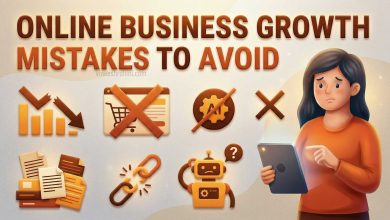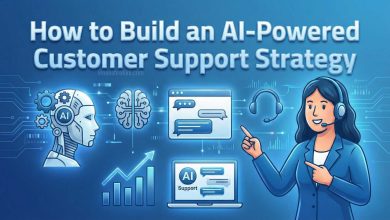Where to Start Affiliate Marketing ? : Comprehensive Guide 2024
Where to Start Affiliate Marketing : Affiliate marketing has grown into a multi-billion-dollar industry and provides a lucrative opportunity for individuals to earn a passive income. Whether you’re looking to supplement your full-time job, launch a side hustle, or build an online business, affiliate marketing offers a flexible and scalable way to generate income.
Table of Contents
However, starting as an affiliate marketer can be daunting due to the vast number of choices, strategies, and tools available. This guide breaks down where and how to begin, helping you navigate the early stages of affiliate marketing effectively.
Also Read : How To Start An Online Store In 8 Steps
Understanding Affiliate Marketing Basics

Before diving into the steps to get started, it’s essential to understand what affiliate marketing entails:
- What is Affiliate Marketing? Affiliate marketing involves promoting products or services of another company and earning a commission for every sale, click, or lead generated through your unique referral link. As an affiliate marketer, you serve as a bridge between potential customers and the brands or products you promote.
- The Key Players in Affiliate Marketing
- Merchant/Advertiser: The company or business offering the product/service.
- Affiliate/Publisher: The person or business promoting the product.
- Consumer: The end-user or customer who buys the product.
- Affiliate Network (optional): A third-party service connecting merchants with affiliates, managing tracking and payments.
Step 1: Identify Your Niche
Choosing the right niche is a foundational step in affiliate marketing success. Your niche determines the type of products you will promote, your target audience, and how you’ll position yourself in the market.
- Assess Your Interests and Expertise
- Start with topics you are genuinely passionate about or have expertise in. This will help you create engaging and authentic content consistently.
- Examples of popular niches include health and fitness, technology, beauty and skincare, travel, finance, lifestyle, and gaming.
- Evaluate Market Demand and Competition
- Research if there’s a demand for the products or services within your niche. Use tools like Google Trends, keyword research tools (e.g., Ahrefs, SEMrush), and Amazon Best Sellers to gauge popularity.
- Check the competition within the niche. High competition may indicate good market demand, but breaking in could be challenging. On the other hand, a niche with too little competition may lack sufficient market demand.
- Narrow Down Your Niche
- Broad topics can be overwhelming, so it’s wise to narrow down your niche. For example, instead of targeting “fitness,” you can specialize in “fitness for busy moms” or “home workout routines for beginners.”
Step 2: Research and Join Affiliate Programs
Once you’ve selected a niche, the next step is finding affiliate programs that align with your niche and audience.
- Types of Affiliate Programs
- High-Volume, Low-Payout Programs: Programs that offer low commission per sale but have a high sales volume. Examples include Amazon Associates, which offers a vast selection of products but relatively low commission rates.
- High-Payout, Low-Volume Programs: Programs that offer high commission rates but require high-value sales. Examples include SaaS (Software as a Service) tools and digital courses.
- Recurring Programs: These programs pay commissions on a recurring basis as long as the referred customer continues using the product/service. Examples include web hosting services and membership platforms.
- Research Popular Affiliate Networks
- Amazon Associates: Suitable for beginners due to its broad product range and easy-to-join nature.
- ShareASale: Features thousands of merchants across multiple niches.
- CJ Affiliate (formerly Commission Junction): Offers access to a large number of established brands.
- Rakuten Marketing: Provides access to global brands with competitive payouts.
- ClickBank: Focuses mainly on digital products with generous commissions.
- PartnerStack: Ideal for SaaS and technology-related products.
- Direct Affiliate Programs
- Some companies run their own affiliate programs independent of networks. Check the websites of companies in your niche to see if they offer an affiliate program. Examples include Shopify, Bluehost, and Canva.
- Apply to Affiliate Programs
- Make sure your application is professional and tailored to the brand’s requirements. Having a website, blog, or a substantial social media following can increase your chances of acceptance.
- Pay attention to terms and conditions, commission rates, payment structure, and rules for promotion.
Buy Now : Ecommerce Website With 100 Products
Step 3: Create a Platform for Promotion

To succeed in affiliate marketing, you’ll need a platform where you can create content and promote products. Here are some common platforms to consider:
- Build a Blog or Website
- Benefits: Having a dedicated website gives you complete control over your content, builds credibility, and helps with long-term SEO growth.
- How to Start: Choose a domain name related to your niche, set up hosting, and use a CMS (like WordPress) to build your site. Create a few high-quality, evergreen blog posts before launching.
- Content Ideas: Product reviews, comparisons, tutorials, buying guides, listicles, and personal stories.
- Monetization Tip: Place affiliate links strategically in your blog posts, ensuring they provide value and are contextually relevant.
- Leverage Social Media Platforms
- Instagram: Use visuals, stories, reels, and posts to showcase products, share testimonials, and provide actionable tips. Use affiliate links in your bio or swipe-up links (if eligible).
- YouTube: Create video content such as tutorials, reviews, and “best of” lists. Include affiliate links in your video descriptions.
- Facebook Groups and Pages: Build a community around your niche, engage users, and share valuable affiliate content.
- TikTok: Make engaging short-form videos to promote products creatively.
- Pinterest: Use visually appealing pins linking to affiliate articles, blogs, or landing pages.
- Build an Email List
- Benefits: Email marketing offers a direct way to communicate with your audience. It helps nurture relationships and drive sales over time.
- How to Start: Use opt-in forms, lead magnets (e.g., e-books, checklists), and pop-ups to grow your subscriber list. Send valuable content regularly, and subtly introduce affiliate promotions.
- Create a Landing Page or Funnel
- Purpose: Direct traffic to focused landing pages that promote a specific offer, increasing the likelihood of conversion.
- Tools to Use: Platforms like ClickFunnels, Leadpages, or simple WordPress plugins can help you build attractive landing pages.
Step 4: Create Quality Content
Content is the backbone of affiliate marketing. To succeed, you must create content that resonates with your audience, builds trust, and drives action.
- Focus on Value
- Provide helpful, educational, or entertaining content related to your niche. Address your audience’s pain points, solve their problems, and guide them in making informed decisions.
- Write Product Reviews and Comparisons
- Share your honest experiences and thoughts about the product. Highlight the pros, cons, unique features, and your overall verdict.
- Include personal stories and use cases to make your reviews more relatable.
- Create How-To Guides and Tutorials
- Showcase how to use a product, demonstrate its benefits, and explain why it’s valuable.
- For complex products or tools, create step-by-step guides that help users maximize their benefits.
- Use Multiple Content Formats
- Experiment with articles, infographics, videos, reels, podcasts, and more to engage your audience on different levels.
- Add Clear Calls-to-Action (CTAs)
- Encourage users to click on your affiliate links with compelling CTAs, such as “Check out this product,” “Grab your exclusive discount here,” or “Learn more about this amazing deal.”
Step 5: Optimize and Promote Your Content
Creating great content is only the beginning. To succeed, you need to promote it effectively and optimize for conversions.
- Optimize for Search Engines (SEO)
- Perform keyword research and incorporate relevant keywords into your content naturally.
- Focus on optimizing meta titles, meta descriptions, headers, and image alt tags. Link internally to other related posts on your site.
- Utilize Social Media Marketing
- Share your content on social media platforms to reach a wider audience.
- Use relevant hashtags, engage with your followers, collaborate with influencers, and consider paid promotions if within your budget.
- Leverage Paid Advertising
- Consider running PPC (Pay-Per-Click) campaigns on Google, Facebook, Instagram, or other platforms.
- Focus on targeting audiences who are more likely to convert based on their interests and behaviors.
- Network with Other Affiliates
- Join forums, communities, or groups dedicated to affiliate marketing. Networking helps you stay updated with trends, share experiences, and even gain backlinks.
Step 6: Monitor Performance and Optimize

Regularly tracking your performance is crucial for improving your affiliate marketing efforts. Use data-driven insights to refine your approach and increase your earnings.
- Use Analytics Tools
- Google Analytics: Track user behavior, traffic sources, bounce rates, and conversions.
- Affiliate Dashboard Reports: Many affiliate programs provide insights into clicks, sales, and earnings.
- Test and Tweak Your Strategies
- A/B Testing: Experiment with different headlines, calls-to-action, layouts, and promotional strategies.
- Split Testing Affiliate Links: Test different placements, anchors, and variations of affiliate links.
- Identify High-Performing Content
- Analyze which content drives the most conversions and double down on similar topics.
- Repurpose high-performing content into different formats to maximize reach.
- Optimize for User Experience (UX)
- Ensure your website is mobile-friendly, loads quickly, and offers seamless navigation.
- Minimize distractions and guide users to desired actions (clicking affiliate links) intuitively.
Overcoming Challenges in Affiliate Marketing
While affiliate marketing offers tremendous potential, it is not without challenges. Here’s how to overcome common hurdles:
- Finding Profitable Products to Promote
- Research products with high demand and good commission rates. Don’t just chase high commissions; promote products that align with your niche and audience needs.
- Building and Maintaining Trust
- Always disclose affiliate links and promote products authentically. Building trust is essential for long-term success.
- Generating Traffic
- Leverage SEO, social media, paid ads, and content marketing to drive targeted traffic to your affiliate links.
- Adapting to Market Changes
- Stay updated with industry trends, algorithm changes, and evolving consumer preferences. Continuously learn and adapt.
- Managing Time and Resources
- Treat affiliate marketing like a business. Allocate dedicated time, plan your content strategy, and prioritize tasks.
Where to Start Affiliate Marketing : Conclusion

Starting affiliate marketing can seem overwhelming, but by taking a structured approach, you can build a sustainable and profitable business. Begin by choosing a niche, joining suitable affiliate programs, creating valuable content, building an audience, and optimizing your marketing efforts. Focus on providing value, building trust, and continuously learning from your results. With consistency, patience, and dedication, affiliate marketing can become a rewarding venture that offers financial freedom and flexibility.
Buy Now : Food Delivery Website With Free Android App
Are you ready to take your first steps into affiliate marketing? Let this guide be your road map to success, and remember, every successful affiliate marketer once started from the beginning—just like you.
Keywords : Where to Start Affiliate Marketing – Where to Start Affiliate Marketing 2024 – Where to Start Affiliate Marketing 2025 , Where to Start Affiliate Marketing in India



